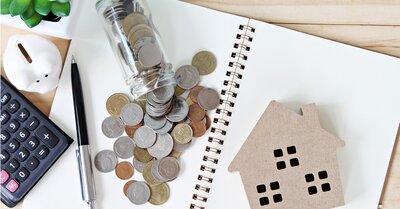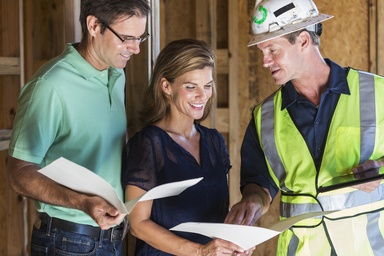You might not know that the Federal Housing Administration (FHA) can help you fund your home renovations, from room additions to smaller maintenance projects. Of course, the best FHA loan program for you depends on your situation and your needs. You can choose the "FHA 203(k)" mortgage for larger projects -- buying a fixer-upper or refinancing your home while also funding a home improvement. Another option is FHA's "Title 1" loan, which allows you to finance your smaller renovation and isn't tied to a refinance or home purchase. For either of these loans, you need to go to an FHA-approved mortgage lender.
"Full" FHA 203(k) Mortgage
The "full" FHA 203(k) home loan allows you to buy a home or refinance a mortgage while incorporating home improvement into the project. To be eligible, you must:
- Meet FHA's credit, income and other underwriting guidelines;
- Finance a house that is at least one year old;
- Borrow a total amount that is less than the FHA's maximum loan amount for your area; and
- Have at least $5,000 for rehabilitation or renovation costs.
The "full" FHA 203(k) is intended for major home renovation or rehabilitation. Luxury items and improvements are not eligible as a cost of rehabilitation, but many upgrades are. Here are just some of the repair and remodeling projects that can be financed with a 203(k) loan:
- Making structural changes or reconstructing
- Modernizing and improving your home's function
- Eliminating health and safety hazards
- Improving your home's appearance and eliminating obsolescence
- Reconditioning or replacing your home's plumbing
- Installing a well and/or septic system
- Adding or replacing roofing, downspouts, or gutters
- Adding or replacing flooring
- Making site improvements or adding landscaping
- Making the home handicap accessible
- Undertaking green renovations or energy conservation projects
These projects are especially useful for bringing an old home up to code.
Your maximum refinance loan amount (subject to FHA loan limits) is the lowest of these three calculations:
- Your current mortgage(s) on the property plus rehabilitation and certain closing costs.
- The current property value plus rehabilitation costs.
- 110% of the improved value multiplied by FHA's 96.5% maximum loan-to-value ratio.
If the property was owned for less than one year, the acquisition cost plus the documented rehabilitation costs must be used. Two appraisals are performed -- one to determine the "as-is" or current property value, and the other to get an "improved value." If, for example, you owe $200,000 on a property worth $205,000, you need $50,000 for improvements, your closing costs are $5,000, and the improved value of the property would be $250,000, your loan amount would be the lowest of:
- $200,000 + $50,000 + $5,000 = $255,000
- $205,000 + $50,000 = $255,000
- $250,000 x 1.10 x 0.965 = $265,375
So in this case, your maximum loan amount is $255,000. Your current mortgage is paid off and replaced with an FHA mortgage.
"Limited" FHA 203k
If the cost of the expected improvements is less than $35,000, the FHA offers a "limited" version of the 203k loan, and you can generally occupy the home while the upgrades are being made. The "full" 203k is intended for major structural changes/repairs -- expansions, replacing plumbing, etc., that would render the home uninhabitable until the process is complete.
The limited FHA 203(k) can be used for projects that include be aren't limited to
- Remodeling a kitchen
- Painting the interior or exterior of the home
- Purchasing new carpet
- Repair, replacement or upgrade of existing HVAC systems
- Repair or upgrades for plumbing or electrical systems
- Weatherization projects, such as storm doors and windows
- Adding insulation and weather stripping
- Repair, replace or add exterior decks, patios, porches
- Many other similar projects
The drawback to any FHA program is that mortgage insurance is not only required, but is it non-cancelable for as long as you own the home.
An alternate: FHA Title 1 Home Loan
If you like your current mortgage (perhaps because you have a low interest rate or are not subject to mortgage insurance premiums), and you don't need a huge loan for your home improvement, an FHA Title 1 loan may be perfect for you. You can't buy luxuries like swimming pools or outdoor fireplaces with the loan. HUD says that "Title I loans may be used for any improvements that will make your home basically more livable and useful", which can cover everything from "dishwashers, refrigerators, freezers, and ovens that are built into the house" to "energy conserving improvements or solar energy systems."
Title 1 loans allow you to borrow up to $25,000 for up to 20 years on approved improvements. Some of the advantages of Title 1 Loans are:
- Low closing costs since you aren't refinancing your first mortgage
- Easy processing. If your loan is less than $7,500, all you need is a signature - there is no lien recorded against your home
- You can do the work yourself if you are qualified
- Manufactured homes that qualify as real property are eligible for Title 1 loans, too (a max of $25,090 for as long as 15 years)
Keep in mind that these loans are funded by lenders, not by HUD; HUD only insures the lenders against loss. Since they are "open market" loans, the interest rates and loan fees are determined by the current market. Shop around with different FHA-approved mortgage lenders to find the best interest rates, just as you would for any other home loan.
Non-FHA Renovation Mortgages
Fannie Mae and Freddie Mac offer mortgage programs similar to the FHA's 203(k) program, called HomeStyle and CHOICERenovation, respectively.
These essentially works in the same manner as the FHA 203k. Fannie Mae notes that their "HSR mortgage provides a convenient way for borrowers to make renovations, repairs, or improvements totaling up to 75 percent of the as-completed appraised value of the property with a first mortgage, rather than a second mortgage, home equity line of credit, or other, more costly financing method. Eligible borrowers include individual home buyers, investors, nonprofit organizations, and local government agencies."
You can usually finance up to 95 percent of the final improved value of the home. Of course, there will also be private mortgage insurance required here as well, but it can be canceled at some point in the future when your equity stake exceeds 20 percent.
Gina Pogol contributed to this article.



